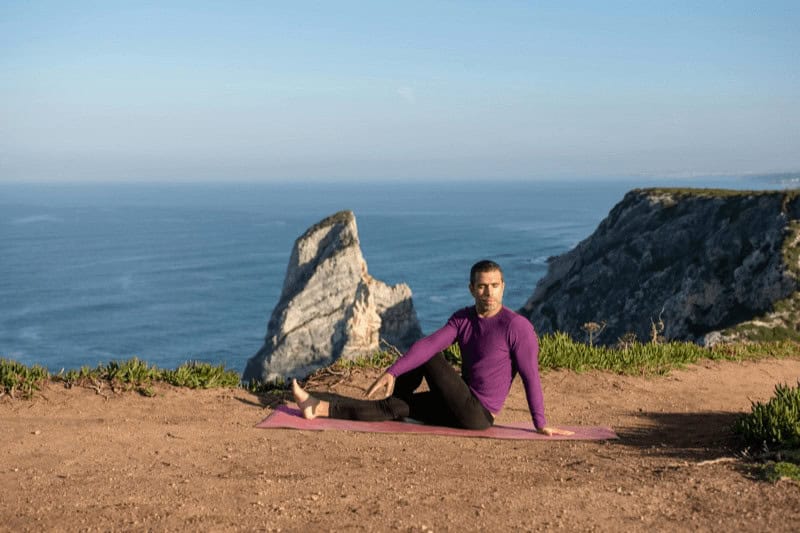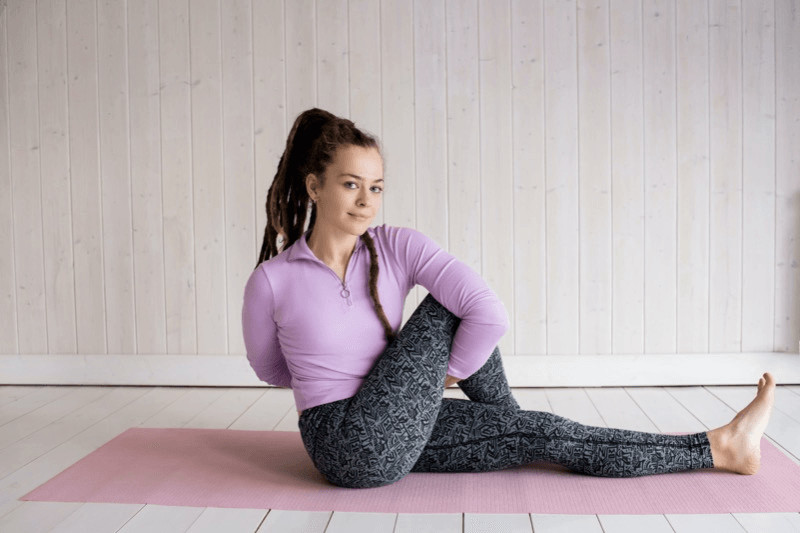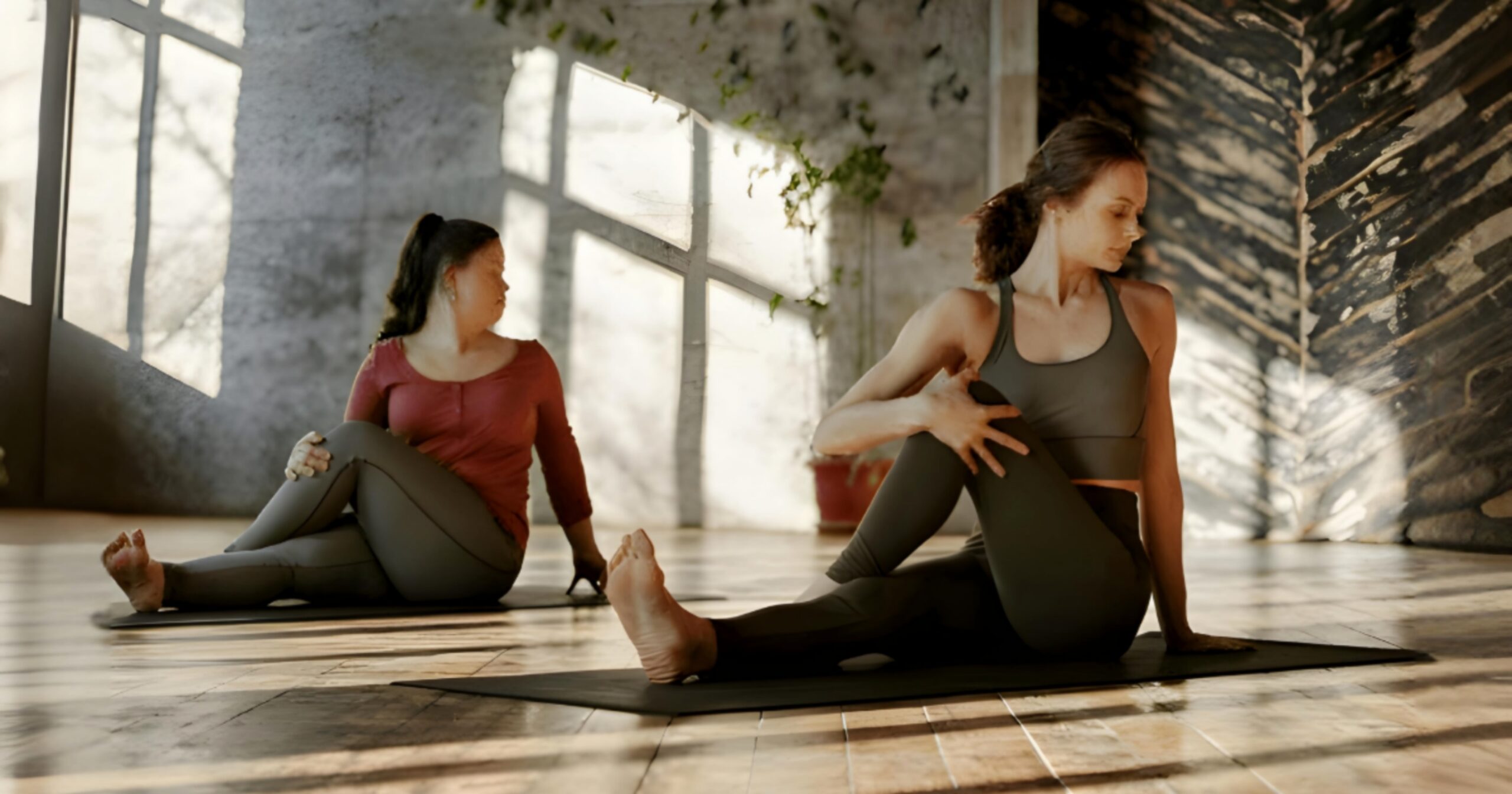Listen to this article:
Key Takeaway
Ardha Matsyendrasana, also known as Half Lord of the Fishes Pose, has deep roots in yoga history, offering both physical and mental benefits such as spinal mobility and stress relief. Learn how to successfully perform this pose following a step-by-step approach, along with modifications to make it more accessible.
| HALF LORD OF THE FISHES POSE | |
|---|---|
| Alternate name: | Ardha Matsyendrasana |
| Difficulty level: | Intermediate |
| Pose category: | Seated |
| Muscle groups: | Erector Spinae (Back) External Obliques (Abdomen) Gluteus Maximus (Hips) Piriformis (Hips) Psoas Major (Hips) Rhomboids (Upper Back) Trapezius (Upper Back) |
| Physical benefits: | Enhances spinal flexibility, aids in digestion. |
| Therapeutic applications: | Enhances spinal health, Alleviates mild back pain. |
| Preparatory poses: | Cat and Cow Stretch (Marjaryasana and Bitilasana) Easy Pose with a Twist (Sukhasana with a Twist) Head to Knee Pose (Janu Sirsasana) |
| Counterposes that follow well: | Seated Forward Bend (Paschimottanasana) Bridge Pose (Setu Bandhasana) Cow Face Pose (Gomukhasana) |
| Chakras activated: | Manipura Chakra (Solar Plexus Chakra) |
| Most helpful prop: |  Yoga block under hand - Increases stability, lengthens spine. See latest price |
Like many yoga teachers, I love adding twisting poses to my yoga sequences. There’s something so rejuvenating and refreshing about “wringing” out all the tension that accumulates in the back and spine, especially after a long day seated at a desk.
One of my favorite twists to include in my classes is the seated spinal twist Half Lord of the Fishes Pose, or Ardha Matsyendrasana. This asana brings all the benefits of twisting poses, like improved posture, spinal flexibility, and stress relief. It’s no wonder yogis have been practicing this pose for centuries!
Join me in an exploration of this foundational pose. We’ll delve into its history, step-by-step practice instructions, and inspiration for integrating Ardha Matsyendrasana into your yoga routine. Roll out your mat and prepare your mind for some profound yoga asana knowledge.
Watch our recommended steps for entering, holding, and exiting the pose.
Contents
- 1 Ardha Matsyendrasana’s Historical Origins
- 2 Step-by-Step Guide to the Pose
- 3 Alignment Cues for Yoga Teachers
- 4 Modifications for Beginners
- 5 Half Lord of the Fishes Pose Variations
- 6 Cautions and Contraindications
- 7 Preparatory Poses to Enhance Practice
- 8 Half Lord of the Fishes Pose Benefits
- 9 Using This Asana in Your Yoga Sequences
- 10 Summary
- 11 Frequently Asked Questions
Ardha Matsyendrasana’s Historical Origins
Ancient Texts
Half Lord of the Fishes Pose, or Ardha Matsyendrasana, is deeply rooted in yoga history and holds a special place within the vast library of yoga postures. The ancient yoga texts Hatha Yoga Pradipika and Gheranda Samhita mention this pose as a foundational yoga asana in the Hatha tradition.
Mythological Link
Yoga teachers love weaving bits of mythology into our classes, like this tale that inspires the pose name Ardha Matsyendrasana:
One day, Lord Shiva was sharing his sacred yogic knowledge with his spouse, Parvati. He noticed a fish nearby who had overheard the conversation. Lord Shiva recognized the fish’s earnest desire for knowledge and transformed him into a sage named Matsyendra, or Lord of the Fishes.
Matsyendra became a disciple of Lord Shiva, spreading his teachings as one of the first Hatha yogis. This yoga asana honors him with its name, “Matsyendrasana,” meaning Matsyendra’s pose.
When you practice this asana, you are paying homage to an important figure in yoga history.
Step-by-Step Guide to the Pose
When I include Ardha Matsyendrasana in my yoga sequences, I guide my students through these steps to ensure proper alignment.
Set Up in Staff Pose
- Come to a seat on your yoga mat with both legs extended in front of you and your feet flexed.
- Ground both sitting bones into the floor with your weight equally distributed.
- Bring your fingertips beside your hips and press them into the floor to sit tall and create length in your spine.
Position the Lower Body
- From Staff Pose, bend your right leg and place the sole of your foot next to your left thigh.
- Keep sitting tall as you hug your right leg toward your chest for 1 to 2 breaths.
- Then, cross your right foot over your left leg, placing it on the floor to the outside of your left thigh.
- Again, sit tall and hug your right leg toward your chest for a couple of breaths to help your glutes release.
Move into the Twist
- First, create length in your spine. As you inhale, grow taller through the crown of your head.
- With your exhale, turn toward your crossed leg. Place your left elbow on the outside of your right leg.
- Reach your right arm behind you, bringing your fingertips to the floor.
- Use your breath to deepen your twist. With your inhale, lengthen your spine. With your exhalation, twist a bit deeper, finally turning your head to look over your right shoulder if it feels okay for your neck.
- When you arrive at your full expression of Ardha Matsyendrasana, hold the twist for 3 to 5 breaths.
Safe and Gentle Release
After this deep spinal twist, take your time to release. Reverse the directions you followed to enter the pose. Bring your torso to face the front of your mat, then uncross your left elbow. Finally, extend your right leg and return to your starting position in Staff Pose.
I often like to add a Seated Forward Bend before switching to the next side. However, you can also sit tall in Staff Pose for a few breaths, stretching your spine. Then, repeat Half Lord of the Fishes Pose on your other side, bending your left leg and twisting to your left.

Alignment Cues for Yoga Teachers
Here are some of my personal yoga teacher tips to help you achieve the optimum alignment in your Half Lord of the Fishes Pose:
- Remember, the movement here is rotation, not bending! I often see students leaning to one side as they turn their torso. Keep your shoulders aligned over your hips rather than leaning to one side.
- To maintain length in your spine, keep your back arm straight and press into the fingertips of that hand. This will help prevent rounding the lower back.
- Ground down equally through both sitting bones. If you have tight glutes, the hip of your top leg might lift up off your mat. If this happens, place your crossed foot closer to the knee of the straight leg rather than tucking it close to the opposite hip.
Breath Synchronization
One of my favorite aspects of teaching Ardha Matsyendrasana is using breath control to deepen your spinal rotation. Inhale and lengthen through the spine before you twist further on an exhalation.
I prefer to use 3 breaths to arrive at my full expression of Ardha Matsyendrasana, twisting the spine from the bottom up.
- I twist from my lumbar (lower back) with my first exhale.
- Then, I rotate in my thoracic region (mid-back) on my second exhale.
- Finally, I take the twist into my cervical spine by turning my head to look over my shoulder.
This technique also reminds me to take my time moving gently into the twist rather than using torque and force.
Modifications for Beginners
Prop Support
Never underestimate the power of a simple prop modification! A little support can help you maintain comfort as you reach your full expression of Ardha Matsyendrasana.
Blanket: Elevate the hips slightly by sitting on a folded blanket to make the pose more comfortable. I recommend this from hugger mugger.

Hugger Mugger Recycled Plaid Yoga Blanket - Black - Use as a Yoga Prop, Made from Recycled...
Yoga block: If the hand reaching behind you doesn’t reach the floor, place a block underneath it to give you stability and help you lengthen your spine. Here is one from lululemon.

lululemon’s Lift and Lengthen Yoga Block
Twist Depth
When first attempting this pose, it’s important not to force your body into a deep twist. For example, instead of bringing your elbow to the outside of your bent leg, you can wrap your arm around it and hug it toward your chest as you turn your shoulders to the side.
Fellow yoga teachers would agree that it’s far better to maintain alignment by keeping the spine long rather than twisting as far as possible. Always listen to your body and respect its limits, especially in spinal twists!
Chair Variation
For those with limited mobility who are unable to get down on the ground, you can practice a variation of Ardha Matsyendrasana in a chair:
- Sit a bit forward on your seat with both feet planted on the ground.
- Lift your right leg and cross it over your left, with your right calf resting against your left thigh.
- Turn your torso to the right, bringing your right hand to the outside of your right leg.
- Reach your right arm behind you and grasp the back edge of your chair.
- Hold your twist for 30 seconds, then gently release and lower your right leg.
- Repeat this seated Ardha Matsyendrasana variation on your other side, crossing your left leg and twisting to the left.
Half Lord of the Fishes Pose Variations
To add variety to your yoga sequences, try these variations of Ardha Matsyendrasana.
Bind the Arms
This variation opens your shoulders and provides a deeper twist.
From your full expression of Ardha Matsyendrasana, wrap your left arm under your right thigh. Reach your right arm behind your back and clasp your fingers together.
Bent Leg Variation
In this version of Half Lord of the Fishes Pose, bend your lower leg and tuck your foot close to your opposite hip. Extend your crossed arm and place your hand on top of the foot of your crossed leg.

Cautions and Contraindications
Spinal twists like Half Lord of the Fishes Pose can be intense. People with certain medical conditions may be at risk for injury and may need to skip this posture.
- Back injuries: If you have chronic back issues or a recent injury, it’s best to avoid twisting poses. This includes slipped or herniated discs or recent surgery.
- Neck issues: Be mindful of neck discomfort in this pose and adjust your position to avoid strain. For example, if I wake up with a stiff neck, I’ll avoid turning my head in Ardha Matsyendrasana and keep my gaze forward instead.
- Pregnancy: If you are in your second or third trimester of pregnancy, it’s best to skip this pose, as the twist puts too much pressure on the abdominal region.
Preparatory Poses to Enhance Practice
When adding Half Lord of the Fishes Pose to your yoga sequences, take these steps to be sure your body is adequately prepared for the pose.
Cat and Cow Stretch
Warm up and mobilize your spine with a few rounds of Cat and Cow Stretch. Come to your hands and knees on your yoga mat. Inhale and drop your belly, arching your back. Exhale and round your spine, dropping your chin to your chest. Repeat a few rounds, moving with your breath.
Easy Pose With a Twist
Prepare your spine for rotation while gently opening your hips. Sit in Easy Pose and turn your torso to the right, bringing your hands to the outside of your right leg. Repeat on the other side.
Head to Knee Pose
This seated pose will lengthen your hamstrings and gently open the hip of the bent leg.
Sit on your mat in Staff Pose with both legs extended. Bend your right leg, bringing the sole of your foot against your left inner thigh. Reach your arms up with your inhale, and fold over your left leg as you exhale. Hold the stretch for at least 30 seconds, then rise, return to Staff Pose, and repeat on your other side.
By focusing on these preparatory poses, you’ll safely achieve your full expression of Half Lord of the Fishes Pose.
Half Lord of the Fishes Pose Benefits
- Relieves stress: This pose releases physical tension from the back and shoulders, helping you feel more relaxed. Additionally, as you focus on your breathing, your mind becomes calm.
- Enhances spinal health: The twisting action of this asana gently compresses and decompresses intervertebral discs, circulating fluid more efficiently. The spinal rotation increases flexibility to help maintain optimal mobility.
- Improves posture and body awareness: Practicing Ardha Matsyendrasana cultivates postural awareness, translating to better posture outside your yoga practice.
- Aids in digestion: Twisting yoga poses can increase circulation to the abdominal region, stimulating the digestive organs and helping move things along the digestive tract.
- Alleviates mild back pain: Half Lord of the Fishes stretches the piriformis, a gluteal muscle that can cause sciatica pain. It’s also fantastic for releasing tension when you wake up stiff or after sitting at a desk all day.
Using This Asana in Your Yoga Sequences
As a yoga teacher, I love finding creative ways to incorporate Half Lord of the Fishes Pose into my yoga sequences. Here are some of my favorite poses to pair with Ardha Matsyendrasana.
- Seated Forward Bend: These postures complement one another perfectly. Lengthen your hamstrings in Seated Forward Bend, then decompress your spine with Half Lord of the Fishes.
- Bridge Pose: The spinal extension of Bridge Pose works well to mobilize and open the spine in conjunction with Ardha Matsyendrasana.
- Cow Face Pose: This posture resembles Ardha Matsyendrasana, with one leg crossed over, stretching the gluteal muscles. In contrast, the upper body faces front as the upper back and shoulders stretch, making this a wonderful counterpose to a spinal twist.
Ready to flow? Check out Yogadownload.com’s library of free yoga classes!
Summary

In exploring the intricacies of Half Lord of the Fishes Pose, we’ve discovered a transformative posture that intertwines myth, movement, and mindfulness. When you practice this asana, you connect your body, mind, and breath while at the same time honoring yoga’s sacred knowledge.
Regularly practicing this pose unlocks the potential for benefits like spinal flexibility, improved digestion, and a calm state of mind. As you incorporate this asana into your practice, I encourage you to make this pose uniquely your own by exploring different variations, being mindful of contraindications, and embracing modifications when necessary.
Embrace the challenge, savor the release, and let Half Lord of the Fishes Pose be an inspiration for self-discovery. Ardha Matsyendrasana serves as a reminder that every inhale, every exhale, and every twist holds the potential for growth and transformation.
Pop quiz! 🧘🤔
The name Ardha Matsyendrasana comes from an important figure in yoga mythology.
Breath awareness is an essential component of practicing Half Lord of the Fishes Pose.
Half Lord of the Fishes is a standing yoga pose.
Frequently Asked Questions
What is Half Lord of the Fishes Pose?
Also called by its Sanskrit name, Ardha Matsyendrasana, this asana is a beginner to intermediate-level seated spinal twisting pose.
What is the origin of Ardha Matsyendrasana?
Ardha Matsyendrasana, also known as Half Lord of the Fishes Pose, originates from traditional Hatha Yoga practices and is named after the yogi Matsyendranath.
Can beginners modify Half Lord of the Fishes Pose?
Yes, beginners can modify by keeping both feet on the floor or using props like a cushion to maintain balance and alignment during the pose.
What are some benefits of practicing Half Lord of the Fishes Pose?
This pose enhances spinal flexibility, aids digestion, stimulates abdominal organs, and relieves muscle tension around the spine.
Who should not do Half Lord of the Fishes Pose?
Individuals with back injuries or conditions like herniated discs should avoid this pose. Pregnant women should consult their doctor and follow the guidance of a prenatal yoga teacher before attempting this pose.







